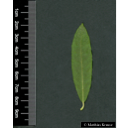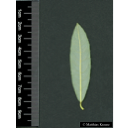Useful information about the taxon (species, subspecies, variety...)
Salix lucida Muhl. 1803
Salicaceae
(APG IV)shining willow
Taxon concept: The Plant List (2014), version 1.1
Distribution: Eastern Canada; northeast and northeast-central United States
Size: 4 - 12 (m)
Flowering period: III - VI
Salix lucida Muhl. - Accepted: Salix lucida Muhl. bei The Plant List (2014), version 1.1; Familie: Salicaceae (APG III)
- Flowers
- dioecious; male (staminate) and female (pistillate) flowers in catkins
- Life form
- small tree or shrub
- Leaves
- lanceolate, 5-13 cm long
- Foliage persistence
- deciduous
- Fruits
- glabrous capsule fruit, seeds with cottony hairs
- Fruit ecology
- wind-dispersed (anemochorous) and water-dispersed (hydrochorous)
- Soil conditions
- on moist to wet silt, sand, gravel or alluvial soils
- Natural occurrence (habitat)
- riparian forests, riparian mixed shrublands, riverbanks, gravelbars, sandbars, backwater sloughs, coniferous forests
- Vegetation typ and synecology (plant community)
- temperate to boreal forests; in communities with black cottonwood (Populus trichocarpa), balsam poplar (Populus balsamifera), thinleaf alder (Alnus incana), boxelder (Acer negundo), other willow species, sometimes Douglas-fir (Pseudotsuga menziesii), in boreal areas (taiga) also with quaking aspen (Populus tremula)
- Natural propagation (all types)
- vegetative reproduction by root crown sprouting
- Comments
- seeds are nondormant
- Usage
- stems (branches) were formerly used for fuelwood, basketry, building material, and as fish weir
- Bark
- thin and smooth
- Altidudinal lower limit (sea level in m)
- 0
- Altitudinal higher limit (sea level in m)
- 3,100
Erhardt, W., Götz, E., Bödeker, N. & Seybold, S. (2008): Der große Zander. Enzyklopädie der Pflanzennamen. Band 2. Arten und Sorten. Eugen Ulmer KG, Stuttgart (Hohenheim), 18. Aufl., 2103 S.; Fryer, J. (2015): Salix lucida, shining willow. In: Fire Effects Information System, [Online]. U.S. Department of Agriculture, Forest Service, Rocky Mountain Research Station, Missoula Fire Sciences Laboratory (Producer). See: https://www.fs.fed.us/database/feis/plants/tree/salluc/all.html; The International Plant Names Index (2009). Published on the Internet http://www.ipni.org; Courtesy to IPNI, 2009. Exported from IPNI at date: 2009-09-22 20:17:51;
Last update:
Taxonomic update: Database method on: 13.1.2021Update of the description: Matthias Krause; latest by: Matthias Krause on: 15.5.2019In the list below you will find the geographic coordinates of many woody plants in the garden. In these cases the points are marked in the map. If no coordinates are listed, the coordinate of the point in the map marks the middle coordinate of the section.| Sex | Standort | Accession number | Planting year | Donation | IPEN | Lat. | Long. |
|---|---|---|---|---|---|---|---|
| Parzelle Z | LG-Z-170-19170 | 2000 | XX-0-HOH-LG-Z-170-19170 | 48,704885 | 9,212795 |


